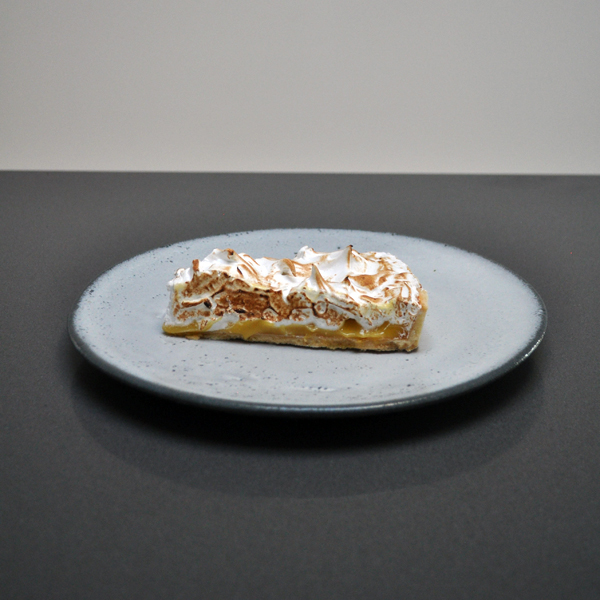Easter Layer Cake 2017
Easter layer cake with mixed spice, almond buttercream, pistachio ganache and filled eggs
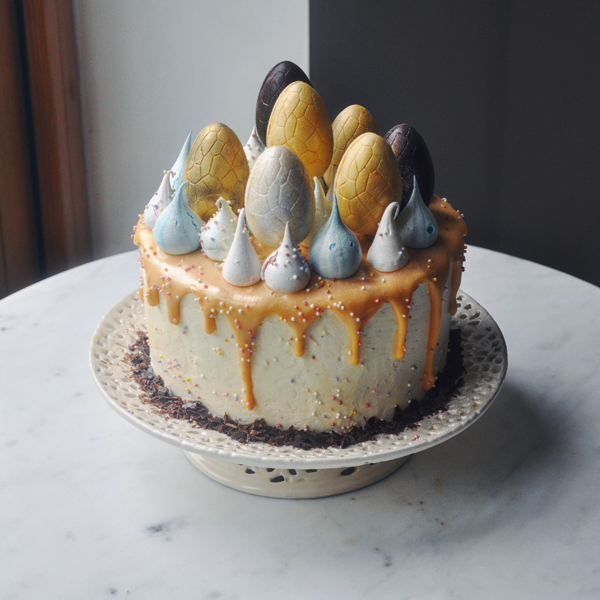
Making actual, proper cakes is something I don't do very often. You guys that do this day in day out are legendary; it's hard work!
A few weeks ago, I made a lemon version of this for Mother's day (are we really already at Easter?), so I thought I'd do it again with an Easter twist. I've provided a list of alternative ingredients at the bottom incase you want to make the lemon version instead.
Ingredients (Makes 1 individual cake, serving 8 people with lots of meringues left for the chef)
For the cakes (you'll need to make 2 and split them both)
- 350g Self-raising flour
- 350g Unsalted butter
- 350g Golden caster sugar
- 6 Whole large eggs
- 10g Baking powder (about 2 teaspoons)
- 10g Mixed spice (about 2 teaspoons)
For the white chocolate pistachio ganache
- 100g Shelled green pistachios or 2 tablespoons of pistachio butter
- 300g Whipping cream
- 300g White chocolate coverture (chips or callets if possible - this is what I'm using at the moment)
For the almond buttercream
- 120g Egg whites
- 200g Caster sugar
- 250g Unsalted butter
- 1 teaspoon of a strong almond extract
For the white chocolate drip ganache
- 150g Whipping cream
- 130g White chocolate coverture
- 20g Cocoa butter
- Paste or powder food colouring (I've used Wilton Ivory here)
For the meringues
- 75g egg whites
- 150g caster sugar
- Blue paste food colouring or any you feel like
Filled Eggs
For the tempered dark chocolate
- 250g Dark chocolate (at least 55% - this is what I've used here)
For the tempered white chocolate
- 250g White chocolate coverture
White chocolate passion fruit ganache filling
- 150g White chocolate coverture
- 150g Whipping cream
- 15g to 25g Passion fruit powder to your own taste (This one from Sous Chef is especially good)
Dark chocolate Manhattan ganache filling
- 150g Dark chocolate (at least 55%)
- 100g Whipping cream
- 30g Bourbon (I've used Four Roses Small Batch)
- 20g Sweet Vermouth (I've used Antica Formula)
- A few dashes of Angostura or other bitters
Other bits
- Gold and silver edible spray
- Dark rum for soaking into the cake layers
Equipment
- 18cm diameter, 8cm tall cake tin
- Plastic or other small egg mould
- Disposable piping bags and nozzles
- Silicone mat
- Stand mixer
- Sieve
- Stick blender
Make the cakes
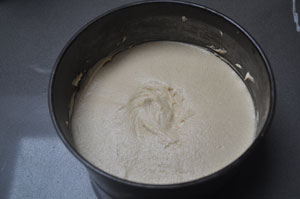
Pre-heat your oven to 170C, and line two (or one if you have to do it twice in the same tin like me) with baking parchment. Spray the insides of your tin and parchment with spray oil, cake spray or lightly butter the surfaces.
Place the butter in your stand mixer with the sugar and cream until the butter is soft. Sieve in the flour and baking powder, then add the eggs and mixed spice. Mix for a few minutes until you get a nice smooth mixture.
Pour half the mix into each cake tin, then level off with a spatula and bake for 35 to 40 minutes (until a chopstick inserted into the middle of the cake comes out clean).
Remove from the oven, and let cool for 10 minutes; then remove from the tins onto a wire rack and leave to cool completely.
Make the pistachio ganache (for both inside the cakes and one of the filled eggs)
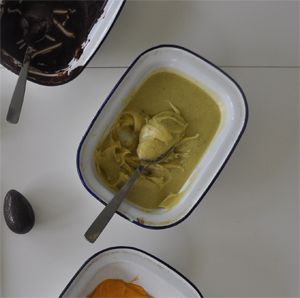
If you're using shop-bought pistachio butter, skip this first section.
Pre-heat your oven to 200C, then spread the pistachios out on a tray and toast for 10 minutes
Pour the nuts into a food processor, and blend for 10 minutes until the oils are released and the nuts turn into butter
Place the double cream in a heavy bottomed pot with around two tablespoons of the pistachio butter and mix with a spatula until combined.
Put the while chocolate into a heat-proof bowl (and chop if you're not using callets).
Heat the cream gently until it starts to bubble, then immediately pour over the white chocolate. Leave it for two or three minutes, then blend with your stick blender until all the white chocolate has melted. Finally, and it should still be warm at this point, add the unsalted butter and blend again.
Pour into a tray, cover with cling film and let set in the fridge for an hour.
Make the passion fruit ganache (for inside one type of filled eggs)
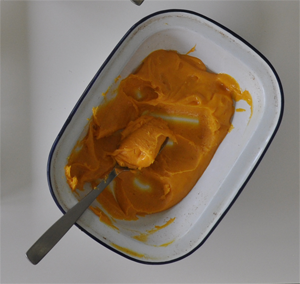
Place the double cream in a heavy bottomed pot and add the passion fruit powder. Stir to combine (note - you can use fresh passion fruit juice here, but it's just not as intense. If you use it, reduce the amount of cream by the weight of juice used)
Put the white chocolate into a heat-proof bowl (and chop if you're not using callets).
Heat the cream gently until it starts to bubble, then immediately pour over the white chocolate. Leave it for two or three minutes, then blend with your stick blender until all the white chocolate has melted. Finally, and it should still be warm at this point, add the unsalted butter and blend again.
Pour into a tray, cover with cling film and let set in the fridge for an hour.
Make the Manhattan ganache (for inside one type of filled eggs)

Place the double cream in a heavy bottomed pot with the vermouth, bourbon and bitters. Stir to combine.
Put the dark chocolate into a heat-proof bowl (and chop if you're not using callets).
Heat the cream gently until it starts to bubble, then immediately pour over the dark chocolate. Leave it for two or three minutes, then blend with your stick blender until all the chocolate has melted. Finally, and it should still be warm at this point, add the unsalted butter and blend again.
Pour into a tray, cover with cling film and let set in the fridge for an hour.
Temper and make the dark chocolate shells

Prepare a pot of water and place a heatproof bowl over the top. Weigh out your chocolate, then place two thirds into the heatproof bowl and reserve the rest.
Using a thermometer, heat and stir the chocolate until it reads between 45C and 50C.
Immediately remove from the heat, and mix in the remaining third of chocolate (chopped or callets) and stir vigorously until mixed. As you're doing this, take occasional temperature readings - when it hits 31 to 32C it's ready to use. If you dip below, very gently heat again over the bain marie - but don't exceed this temperature. If you're struggling to make the last third of the chocolate melt, use a stick blender to help.
When the chocolate is ready, pour it into the shell mould so that it fills them entirely - the amount given in this recipe is for the type of mould I'm using - you may need more or less.
This part all proper chocolatiers will want to collectively punch me in the face for - place your mould into the freezer for 60 seconds. This will help firm the outside of the chocolate shell.
When time is up, remove and pour the excess chocolate out, leaving a layer of around 5 or 6mm around the outside. Place back into the freezer for 5 minutes.
This time your chocolate should be completely solid - so scrape the edges of the mould with a sharp knife to release the shells (keep any shavings for decoration at the end of the cake), then flip the mould and tap hard on your work surface. If you've got a good temper (the chocolate, not your own demeanour) they should fall straight out. You may need to tap or drop the mould a few times to release them all. Reserve the shells for the next stage.
Temper and make the white chocolate shells
Follow exactly the same process above, except that you should wait until the temperature is 28 to 29C until pouring it into the mould.
Fill the shells
Remove the ganaches from the fridge, and spoon the Manhattan one into the dark shells. Smoothen with a spatula, but leave a little extra over the shell's edge. Press two halves together until some of the ganache leaks out, then take a paper towel and rub the excess off around the edge so that the shells stick together.
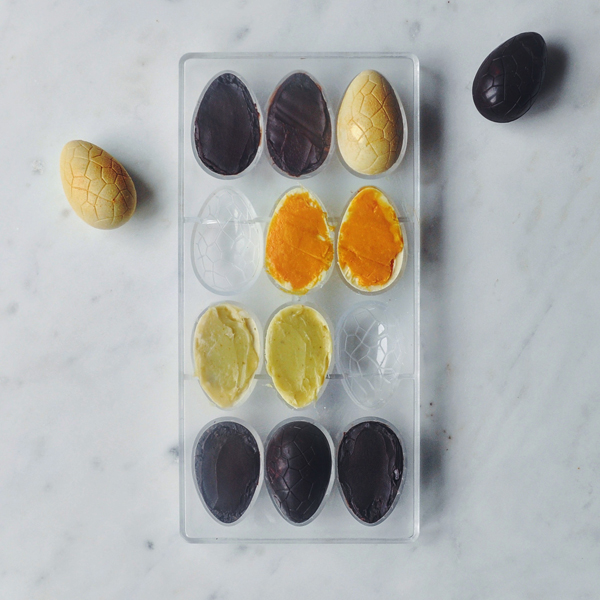
Repeat with the pistachio and passion fruit ganaches - you can mix and match these two between dark and white chocolate if you like; the Manhattan one only works well in the dark shells though!
Reserve the eggs in the fridge
Split and layer up the cake
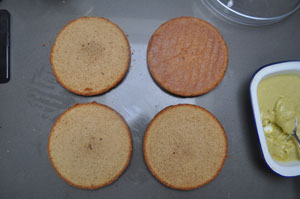
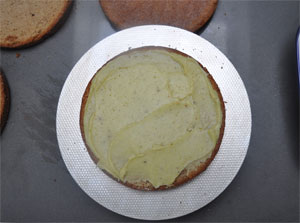
Take each of the two cakes, then cut the top off so that you have an even top and bottom. Split each of these in two, so you end up with 4 pieces of equal height.
Use the bottom of one cooked cake as the base, and the bottom of the other cooked cake as the top so you can really ensure a decent flat surface.
Place your first layer on a board or cake stand, then pour 3 tablespoons of dark rum over the surface as evenly as you can.
Spread around two tablespoons of the pistachio ganache over the cake, then level it up. Repeat with another two layers, then finally place the last layer over the top so you have a 4 layer cake with 3 layers of ganache sandwiched between. Place sin the fridge to firm up.
Make the meringues
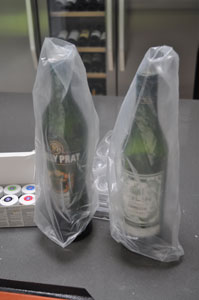
This is the brilliant Meringue Girls technique, which gives a chewy and delicious result.
Heat your oven to 200C, then place the caster sugar into a try lined with baking paper for 7 minutes.
When time's up, reduce your oven 100C.
Place the egg whites in the bowl of your stand mixer and whisk until firm peaks form. Gradually shower in the heated sugar, then keep whisking until the meringue is glossy.
Prepare a tray with a silicone mat, and piping bag with the food colouring - you want to take your piping bag, then turn it inside out, except for a tiny bit where you'll put the piping nozzle. Place this over a tall bottle, then grab your food colouring paste and paint 4 evenly spaced vertical lines from the top to the bottom of the bag. Remove from the bottle, place your piping nozzle in, and invert back the other way.
Fill the piping bag with your meringue, then pat it down with your hands to both remove the excess air and also get the colouring going. Tie, fold or clip the top then cut open the end and push out the nozzle.
Pipe evenly spaced meringues onto the silicone mat, pulling upwards to get a taller meringue. Leave a centimetre or two between each one.
Place in the oven for around 40 minutes
Make the drip ganache
Do this first, as it needs to thicken to exactly the correct consistency, and that can take some time.
Place the cream in a heavy bottomed pot. Weigh the chocolate and cocoa butter into a heat-proof bowl.
Heat the cream until it's bubbling, then pour onto the chocolate. Leave to stand for 2 or 3 minutes, then mix with a spatula or blend with a stick blender. Drop in the paste - I've used Wilton's Ivory colour here. Once completely combined, place in the freezer to firm up.
This is the trickiest part of the recipe; if you've not left it long enough, the ganache will be too runny and simply drip off the cake leaving a mess. If it's too thick it won't drip at all. You want it to be relatively heavy, and closer to fully setting than being liquid. It can take a couple of hours in the freezer - so wait it out, but check regularly. Get on with the buttercream while you're waiting.
Make the buttercream and ice the base cake
Place a pot of water on your hob, and heat until simmering. Weigh the egg whites and sugar into a bowl, then place this over the simmering water. Immediately start to whisk - and I'd recommend a hand-held electric whisk at this point. Keep going until it whips to a stiff peak.
Transfer to your stand mixer bowl, and whisk again. While it's still hot, start dropping the butter in piece by piece until it's all gone. The heat will melt the butter, so it won't cream straight away - but give it 5 or 10 minutes at high speed and you'll end up with a smooth buttercream. Before you stop whisking, add the almond essence.
Finally, ice the cake by plastering the outside and top with buttercream, then placing back in the fridge for 20 minutes. When time's up, remove the cake from the fridge and you'll find the buttercream has firmed up slightly. Begin to smoothen the sides and top with a long spatula. If you've got one of those rotating cake stands, use that by placing the spatula up against the cake and spinning the base instead. You can keep dipping your spatula into warm water if you want to make it really smooth. The top is less important to get totally perfect, as the ganache will cover any minor imperfections.
Place back in the fridge until the drip ganache is ready.
Drip the ganache
When the ganache is just about moving when you spoon it, it's ready. Start to spoon small amounts near the edge; if it starts to drip down the cake all the way to the bottom, it's still not firm enough - so return to the freezer. If it starts to drip and stops somewhere down the buttercream, you're good.
Continue doing this all around the cake using more or less each time so the drips are different lengths.
When you've gone all the way around, use the remaining ganache to fill the top of the cake, then place in the fridge to solidify one last time
To serve
Place a toothpick into the bottom of each egg you're adding to the cake. If you've got / are using gold and silver edible spray, spray them at this stage. Stick 6 or 7 eggs on top at different heights.
Place some meringues around randomly, then finally throw over some hundreds and thousands.
If you kept any of the chocolate scrapings, place these around the bottom of the cake.
Hope you enjoy this one and Happy Easter!
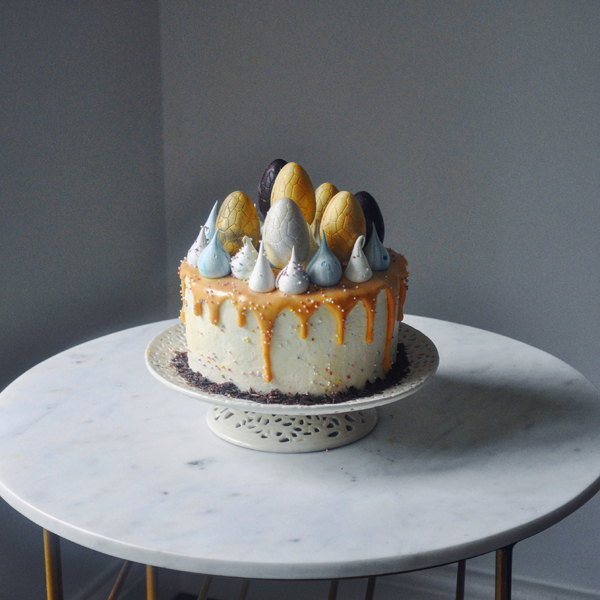
Lemon variation
- Substitute the mixed spice for the zest of two lemons and the juice of half in the cake mix
- When layering, substitute the rum for gin mixed with lemon juice
- When making the buttercream, substitute the almond essence for more lemon zest and a 1/2 teaspoon of vanilla powder or extract
- Instead of the pistachio ganache between the cakes, make or buy lemon curd and spread between each layer. Here's my recipe from way back in post #2
- Instead of the filled eggs, make some lemon macarons filled with curd and whipped cream. Here's one receipe for the shells from post #19
- Substitute out the random colours for yellow!

Seventy Five
A roasted pistachio and rose tartlet to celebrate my Dad's 75th

It was Dad's 75th Birthday this weekend; he's more than double my age, but still insists on balancing ladders on the top of ironing boards, just so he can pick an apple off a tree or destroy a wasps nest. I can only hope to be that able (though perhaps a little less insane) when I get there myself.
When I was young, some of my earliest memories are of my Mum roasting pistachio nuts in the oven, and Dad sitting down eating entire bags of them in one sitting - while somehow managing to stay under 10 stone in weight.
This recipe is a dedication to that memory; a roasted pistachio butter used to flavour sweetened cream, rose crème pâtissière, topped with meringues and another of his favourites - pistachio nougat.
You'll also get some bonus left over pistachio butter for your toast (just add salt or sugar), some meringues and some nougat to have later on.
Ingredients (makes 4 individual tartlets)
For the roasted pistachio butter
- 150g green pistachios (the proper Iranian ones if you can; I get mine from Sous Chef)
For the roasted pistachio cream
- 400g Whipping Cream
- 50g Icing sugar
For the rose crème pâtissière
- 3 large egg yolks
- 250ml whole milk
- 60g caster sugar
- 25g plain or type 45 flour
- 1 to 2 teaspoons of rose flavouring
- Powdered red food colouring (optional - you won't see it until you cut the tart open)
For the tart cases
- 250g type 45 flour [Buy] (or just plain if you don't have any)
- 140g unsalted butter (softened)
- 1 large egg
- 1 large egg yolk
- 40g ground almonds
- 90g icing sugar
- 1/2tsp almond essence
For the rose meringues
- 2 Large Egg Whites
- 65g Icing Sugar
- 65g Caster Sugar
- 1 teaspoon of rose flavouring
- Some crushed pistachio nuts and rose petals for decoration
For the pistachio nougat
- 210g Caster Sugar
- 50g Liquid Glucose
- 60g Honey
- 35g Egg Whites
- 50g Green Pistachio nuts
To finish
- Crushed green pistachios
- Reserved pistachio butter
- Rose petals
Equipment required
- 10cm tart rings
- 9cm circular cutter
- Stand mixer
- Thermometer
- Food processor
- Silicone mat
- Baking beans
- 30cm metal baking tray
- Plastic piping bag and large piping head
Make the roasted pistachio butter
 Turn your oven on to 170°C.
Turn your oven on to 170°C.
Weigh out the pistachio nuts onto a baking tray and, when up to temperature, place in the oven for 8 minutes.
When time's up, remove from the oven and pour into a food processor. Leave to blend for 10 minutes while still hot. You'll see the nuts crush, then get oily, solidify and finally blend into liquid. Stop and scrape down the bowl of your machine when it's liquid to make sure everything has been turned into a delicious pistachio paste.
Decant from the bowl and reserve. Once it's cool, place in the fridge. You can taste it if you like - but I promise it'll be so claggy you won't be able to speak; so maybe don't do that. Protip: If you're having the leftovers on toast, mix in some sugar or salt and that will reduce the sticky mouthfeel.
Make the pistachio cream discs
 When the pistachio butter has cooled, line a high-sided (at least 1/2 inch) baking tray with some greaseproof paper and give it a quick spritz of baking or 1 cal spray.
When the pistachio butter has cooled, line a high-sided (at least 1/2 inch) baking tray with some greaseproof paper and give it a quick spritz of baking or 1 cal spray.
Take the cream and whip with an electric whisk until soft peaks have formed. Shower in the icing sugar and whip again until almost firm.
Next, pour in about 2/3 of the pistachio butter. Whip for a couple of seconds more to blend - just don't overdo it and whip the cream too much; it should hold a shape and not be pourable. If you're nervous about over whipping, fold the pistachio in with a spatula instead.
Spoon the lot into a baking tray, then level off with an angled spatula. Try to get it as level as possible, then place in the freezer to solidify for about an hour.
The rose crème pâtissière
While the cream is freezing, make the creme pat.Place the eggs and caster sugar in a bowl and whisk until pale. Whisk in the flour until a smooth paste is formed. Add the colour at this stage if you're using it.
Pour the milk into a heavy bottomed pan, and heat until it nearly boils. Temper the eggs by pouring a small amount of the hot milk over them while whisking constantly to remove any possible lumps. Keep pouring more and more until all the milk and eggs are combined - then, return the mixture to the pan the lower the heat.
You can use a wooden spoon to continually mix until it's thick - but when making a heavy custard like this I prefer to whisk so that the flour has no chance of getting lumpy. When it looks thick enough to spoon, remove from the heat and pour through a sieve into a clean bowl. You'll need to push the custard through the sieve with the back of a spoon. Add the rose flavouring, and mix thoroughly.
Place cling film directly on top of the custard and leave to cool to room temp - then transfer to the fridge.
Make, bake and fill the tart cases
This recipe uses pâte sucrée.Attach a whisk to your stand mixer, and add the butter. Whip until the butter has been creamed, then add the almond extract, icing sugar, ground almond and eggs. When completely combined (i.e. no butter lumps), tip about 1/3 of the flour in. It should be combined in a few seconds, so repeat with the next 1/3 and then the final amount of flour. Stop the mixer when the mixture looks combined and a bit like wet sand, making sure you don't overwork it.
Turn this out onto your work surface and press it all into a smooth ball. Place the ball on some cling film, then flatten slightly with the palm of your hand. Wrap it in the cling and place in the fridge for at least 2 hours.
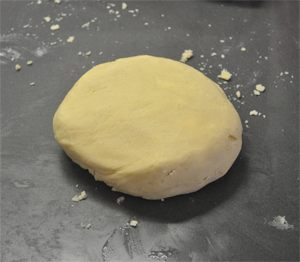

When the pastry has rested, take your baking mat and place it on a tray. Give the mat and rings a quick spritz with baking, 1 cal spray or just grease with butter.
Remove the pastry from the fridge, and unwrap from the cling. Stretch the cling film out, dust the pastry with icing sugar, then place back in the middle. Working really quickly while it's cold, roll the pastry on the cling film to a thickness of about 3mm. Check the width by putting the 4 flan rings on top - you'll need some excess around the edges of each. Cut the pastry into 4 equal pieces.
Remove all but one of the 4 pieces, then use the cling film under the pastry to pick it up, invert and place over one flan ring. Push the pastry into the corners - again, now that the cling is on top, you should be able to do this all by hand without further dusting. When you're happy, carefully peel the cling film off. Make sure any excess pastry is bent and folded over the edges of the case, and that no metal is visible on the upper rim. If it is, cut off some excess dough and push it into place. Sugar pastry is more forgiving than many other types, mainly because you can quite neatly blend any holes with extra pastry.
Repeat with the other four pieces, placing each one back onto the cling, inverting, then pressing in.
Turn your oven on to 170°C.
To help stop shrinkage, freeze the tart cases instead of just putting them in the fridge. Leave it in there for about 30 minutes (not much more - you don't want it to completely solidify) until nice and cold. When you're ready to blind bake, remove the cases from the freezer and place some silver foil (matte side down) into each one. Scrunch it down over the top edges so they are completely covered in foil, then gently pour in your baking beans into each one.
You need to add a bit of extra cooking time due to how cold they are; so bake for about 20 minutes. After this time they should look anaemic but be solid - so carefully remove the foil and beans, then brush with a beaten egg and return to the oven for a further 5 to 10 minutes until golden inside.
Remove and leave to cool to near room temperature, then use a sharp paring knife to trim the outer edge of each one. Carefully remove the rings, then brush out any pastry crumbs.
Make the meringues
 Turn your oven on to 110°C.
Turn your oven on to 110°C.
Beat the egg whites in your stand mixer until soft peaks form - normally less than a minute on a Kitchen Aid up at full whack. Slowly shower in the caster sugar, then leave it running on high for about 5 minutes until you have stiff peaks.
Turn the mixer down to low. Shower in the icing sugar and add the rose flavouring. Give it a quick 30 seconds on high, then turn off and transfer to a piping bag.
Take a baking tray, and place a silicone mat on top. Pipe tall-ish meringues by applying pressure to the bag and pulling upwards. Sprinkle half with crushed pistachio, and half with rose petals.
Place in the pre-heated oven, then cook for 60 minutes.
Make the nougat
Weigh the egg whites into the bowl of a stand mixer and attach the whisk. Line your high sided baking tray with cling film and sprinkle with icing sugar.Place the sugar and liquid glucose in a heavy bottomed pan with a thermometer, and heat to 135°C. At this point, spin up the stand mixer to full and whip the egg whites.
Carefully pour the honey in and heat to 145°C on your thermometer.
When reached, and with the mixer still running, pour the sugar mix onto the egg whites and whip until the mixer bowl feels just warm to the touch. Pour in the pistachios and mix for a moment.
Working quickly before it sets too much, scoop or pour the mix into your tray, sprinkle over some more icing sugar then let set. It will probably only take another 15 minutes.
When set, remove from the cling film and chop into small squares.
Put it all together
Take a tart case, and fill it with rose crème pâtissière right to the edge. Flatten with a spatula.Remove the pistachio cream from the freezer and cut a piece out with your circular cutter. Roll in the crushed nuts, then place on top of the tart case.
Take two pieces of nougat and place those on top of the pistachio disk. Dot over some pistachio butter, then add two or three of each type of meringue. Finally, sprinkle over a few more crushed nuts and some rose petals.
Serve when the cream has thawed - during the summer it will only take about 20 mins at room temp.
Maraschino Cherry Meringue Tart
A cherry curd-filled tart using Luxardo's amazing Maraschino cherries and syrup

It was our 3rd wedding anniversary this week - and as usual, if there's any reason to celebrate something, that means there's a reason to fill our faces.

This recipe, which I did briefly think of calling "toothpaste tart", uses Luxardo's Maraschino cherries. If you've never tried them, you really need to; they aren't the normal bright pink Maraschino cherries that companies like Opies make (a baileys and cherryade please Mike) - instead they're prepared in their natural juice with lots of sugar. The result is a massive cherry flavour. You can grab some from The Whisky Exchange.
While they're great in cocktails, I'm using a whole jar to make curd. Stay with me here, I know they cost about 7 quid - but the curd they make is unbelievable, especially as a treat. Use the recipe below to just make that - or go the whole way and turn it into a tasty dessert to share. Or not.
Ingredients (makes one pie, serves one pie to 8 standard people)
For the filling
- 1 jar of Luxardo Maraschino cherries
- 3 large eggs
- 100g unsalted butter
- 210g caster sugar
For the tart case
- 250g type 45 flour [Buy] (or just plain if you don't have any)
- 140g unsalted butter (softened)
- 1 large egg
- 1 large egg yolk
- 40g ground almonds
- 90g icing sugar
- 1/2tsp almond essence
For the Italian meringue
- 165g egg whites
- 450g caster sugar
- 113g water
- Red paste food colouring (Wilton make a good one)
- 1/2tsp almond essence
Equipment required
- 24 cm flan ring
- Stand mixer
- Thermometer
- 1 baking mat (Fibrelux, Silpat etc)
- 1 heavy tray
- Baking beans or equivalent
- Plastic piping bag and large piping head
Make the curd
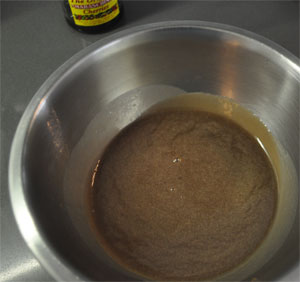
Now prepare your bain marie - bring water to a simmer in a pot, and place a clean bowl over the top. Pour in the syrup, sugar, butter and let them melt together, stirring occasionally. Beat the three eggs until they are homogeneous, then pour that into the juice. Make sure the water stays at a simmer or you'll get scrambled eggs.
Stir slowly until combined, then keep it on the low heat and stir every few minutes. Eventually - and that might be 15 or more minutes in this case - the eggs will start to thicken up as they cook. When you reach a texture that coats the back of your spatula, remove from the heat and strain again into a clean bowl. Note that as it's hot, it will look more "liquid" than curd normally does. If you want to test the thickness, take a teaspoon out and leave it on the side for a few minutes; if it's thick enough you're done. Leave to cool to room temperature, then cover with cling film and place in the fridge for a few hours to firm up.
Make, bake and fill the tart case
This tart uses pâte sucrée.Attach a whisk to your stand mixer, and add the butter. Whip until the butter has been creamed, then add the almond extract, icing sugar, ground almond and eggs. When completely combined (i.e. no butter lumps), tip about 1/3 of the flour in. It should be combined in a few seconds, so repeat with the next 1/3 and then the final amount of flour. Stop the mixer when the mixture looks combined and a bit like wet sand, making sure you don't overwork it.
Turn this out onto your work surface and press it all into a smooth ball. Place the ball on some cling film, then flatten slightly with the palm of your hand. Wrap it in the cling and place in the fridge for at least 2 hours.

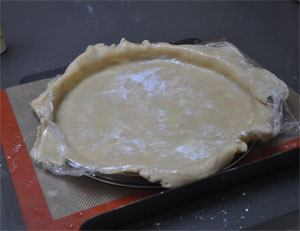
When the pastry has rested, take your baking mat and place it on a tray, then the flan ring on top of this. Give the mat and ring a quick spritz with baking, 1cal spray or just grease with butter.
Remove the pastry from the fridge, and unwrap from the cling. Stretch the cling film out, dust the pastry with icing sugar, then place back in the middle. Working really quickly while it's cold, roll the pastry on the cling film to a thickness of about 3mm. Check the width by putting the flan ring on top - you'll need some excess around the edges.
Since the cling is underneath, you should easily be able to pick up the pastry, invert it and place over the flan ring. Push the pastry into the corners - again, now that the cling is on top, you should be able to do this all by hand without further dusting. When you're happy, carefully peel the cling film off. Make sure any excess pastry is bent and folded over the edges of the case, and that no metal is visible on the upper rim. If it is, cut off some excess dough and push it into place. Sugar pastry is more forgiving than many other types, mainly because you can quite neatly blend any holes with extra pastry.
Turn your oven on to 170C.
To help stop shrinkage, freeze the tart case instead of just putting it in the fridge. Leave it in there for about 30 minutes (not much more - you don't want it to completely solidify) until nice and cold. When you're ready to blind bake, remove the case from the freezer and place some silver foil (matte side down) into it. You will probably need two pieces going in alternate directions to cover the whole ring. Scrunch it down over the top edges of the case so it's completely covered in foil, then gently pour in your baking beans.
You need to add a bit of extra cooking time due to the frozen case, so bake for about 20 minutes. After this time it should look anaemic but be solid - so remove the foil and beans, then brush with a beaten egg and return to the oven for a further 5 to 10 minutes until golden.
Remove and leave to cool to near room temperature, then use a sharp paring knife to trim the outer edge. Carefully remove the ring, then brush out any pastry crumbs. Take your curd and spoon it into the case. Use a palette knife to even the filling out, then scatter the reserved cherries evenly over the top. Cover with cling film, then place in the fridge to firm up again.
Italian meringue and putting it all together

Use a thermometer to measure the temperature of the sugar - when it hits 115C, start to whip your egg whites. When it hits 118C, remove from the heat, and trickle the syrup over the beaten egg whites. Once it has picked up a bit of volume, add the almond essence. Leave this to whisk until completely cool.
While this is happening, prepare the piping bag with the food colouring. This kind of thing has become really popular recently, probably due to the Meringue Girls - I'll describe what to do, but they've got a great video showing you the technique if you get stuck.
You want to take your piping bag, then turn it inside out, except for a tiny bit where you'll put the piping nozzle. Place this over any tall bottle, then grab your food colouring paste and paint 4 evenly spaced vertical slines from the top to the bottom of the bag. Remove from the bottle, place your piping nozzle in, and invert back the other way.
Now the meringue should have cooled down to near room temperature, so stop whisking and fill the piping bag. If you've used a thick enough food colouring paste, the lines will stay as they are. Try to remove any air bubbles from the bag by pressing the meringue from the outside.
Remove the tart from the fridge and snip the top off the piping bag to reveal the nozzle.
Pipe a few test meringues to get the food colouring into place. When they look good, start piping the meringue around the edge of the tart. Pull upwards on the meringues to make them tall as you pipe each one. Once you've finished the complete circle, carry on with the next inner layer, and so on until the entire tart is covered.
When you're happy, fire up your blow torch. Normally I'm up for hardcore meringue toasting - but since you've gone to the trouble of making them look good, a gentle browning will do.
Serve immediately.
Rhubarb & Custard
Custard filled tart topped with a light forced rhubarb & ginger mousse

Full disclosure: I don't like rhubarb. It's one of about 3 ingredients I've never been able to eat.
Sometimes though, I'll venture over to the dark side of the things I hate and try to find a way to love it like everyone else - and, for the first time, it worked; I've been converted to the joys of the manky pink celery stuff.
This recipe was inspired by my favourite chef, Raymond Blanc, and his new show about Kew Gardens. If you've not seen it, I'd recommend it. He made a rhubarb & custard dessert which looked delicious, and made me think "how bad can it really be?"
Makes 6 with mousse left over
Ingredients
For the rhubarb and ginger purée
- 400g forced rhubarb
- 20g piece of ginger
- 75g caster sugar
For the mousse
- 4 leaves of gelatine
- 60g liquid glucose
- 120g caster sugar
- 50g water
- 120g egg whites
- 350g whipping cream
For the pâte sucree
- 250g type 45 flour [Buy] (or just plain if you have it)
- 140g unsalted butter (softened)
- 1 large egg
- 1 large egg yolk
- 40g ground almonds
- 90g icing sugar
- 1tsp vanilla extract
For the crème patissière
- 250g whole milk
- 1tsp vanilla paste, powder or essence
- 3 large egg yolks
- 37g caster sugar
- 12g plain flour
- 10g cornflour
For the white chocolate spray
- 250g white chocolate coverture
- 100g cocoa butter or groundnut oil
- 1tsp red food colouring powder
For the rhubarb tuille
- 1 stick of rhubarb
- 2tbsp grenadine
- 100g water
- 20g caster sugar
To finish
- Spring flower petals
- Gold leaf
Equipment
- Silicone mat
- Stand mixer
- Thermometer
- Spray gun (I use the Wagner W180P)
- 6 inch diameter semi-sphere silicone mould (with 6 holes)
- 6 inch tart rings
Note: there's some freezing and setting time involved here, so either start in the morning or the day before you want to serve them
Rhubarb and ginger purée
Chop the rhubarb into chunks, discarding any woody ends. Slice the ginger, then place both in a pot and cover with the caster sugar. Place over a medium heat, and watch as the rhubarb's juice starts to come out. Cook for about 5 minutes, stirring occasionally, until the rhubarb has broken down. Let it cool slightly to avoid burning yourself, then blend with a stick blender in the pot until you get a fine purée. Sieve it and set aside to cool a little more while you prepare the mousse ingredients.
Mousse
Soak the gelatine in cold water for 5 minutes. When it's soft, squeeze out the water and mix it with the now slightly cooled purée (which should still be too hot to touch with your finger) from the first step. It won't set immediately, but carry on working quickly anyway.
Prepare to make the meringue - place egg whites into the bowl of your stand mixer with whisk attached. Put the caster sugar, liquid glucose and water in a heavy pot over a high heat and start to measure the temperature with your thermometer. You're looking to get to the magic 116 degrees centigrade - so, when you hit around 113, start your stand mixer up on the highest setting to whip the whites. When you reach 116, slowly pour the sugar syrup down the edge of the stand mixer bowl. Leave the mixer running at its highest speed until you get a thick Italian meringue.
Measure out your whipping cream, then whip until it leaves a trail on the surface of the cream.
Once the meringue is cool, pour in the purée and gently combine with a spatula, then do the same with the cream.
Take a 6 hole semi-sphere silicone mould, and spoon in the mousse. Try to make sure it coats the entire outer surface of each half sphere. When full, scrape the top of the mould with a spatula so that everything is level. Place the mould on a tray, and put into the freezer for at least 3 hours.
Rhubarb tuille
Pre-heat your oven to 100C.Raymond used a vegetable peeler to make thin strips of rhubarb, but mine wasn't having any of it. If you also have trouble, just use a sharp knife to slice the stick of rhubarb as wafer thin as you can. Make as many as you can just in case they snap or fail. Place the strips into a heatproof bowl.
Place the grenadine, water and sugar in a saucepan and heat gently until it reaches a simmer, then pour this over the rhubarb. Leave for 10 minutes until cool.
Place a silicone mat on a heavy tray, then lie each thin piece of rhubarb spread out over that. Place it in the oven - mine took about 30 minutes, yours could take less or more time. Keep an eye on them. Alternatively you could use a dehydrator if you have one.
When the slices seem quite hard, remove from the oven to cool. When they've come to room temperature, they should be solid and crisp. Place into a sealed container and reserve for later. Don't put them in the fridge though!
Crème patissière
Pour the milk into a saucepan, add the vanilla and place on a medium high heat. Place the egg yolks and sugar into a bowl and whisk until a pale yellow colour. Next, add the flour and cornflour to the eggs and whisk again until you have a really smooth paste.
As soon as the milk is just about to boil, remove from the heat. Place your egg bowl on a tea towel to stop it moving, then pour a tiny amount of the hot milk over the yolks while you're whisking to temper them. Add a bit more milk, and keep on whisking, then add the rest, whisk for a moment, then pour the mix back in the pan over a more gentle heat.
Keep your whisk going gently, and you'll see it thicken within 30 seconds. Keep mixing, making sure it doesn't catch on the bottom of the pan. When it's very thick (about 60 seconds) pour it into a bowl and leave to cool. When cold enough, cover with cling film and put in the fridge.
Make, bake and fill the tart cases
Attach a whisk to your stand mixer, and add the butter. Whip until the butter has been creamed, then add the vanilla extract, icing sugar, ground almond and eggs. When combined, tip about 1/3 of the flour in. It should be combined in a few seconds, so repeat with the next 1/3 and then the final amount of flour. Stop the mixer when the mixture looks combined and a bit like wet sand.Turn this out onto your work surface and press it all into a smooth ball. Place the ball on some cling film, then flatten slightly with the palm of your hand. Wrap it in the cling and place in the fridge for at least 2 hours.
When the pastry has rested, take your baking mat, place it on a tray, then the individual flan rings on top of that. Remove the pastry from the fridge and, working quickly, dust with icing sugar roll to a thickness of about 3mm. Try and make it as square as possible.
Cut the rolled pastry into 6 even pieces, then carefully - using an offset spatula, the rolling pin or carefully with your hands - lift, and unroll each piece over the rings. This is the part where disaster can strike, so try and start the unrolling with enough "edge" to cover the closest part to where you're standing. If it has worked, start pushing the dough into the edges of each ring, leaving any excess folded over the top. Don't trim it yet. If you find any cracks, just patch them with spare pieces of pastry or some of the edge overhang.
Turn your oven on to 170C.
To help stop shrinkage, freeze the tart cases instead of just putting them in the fridge. Leave the tray in there for about 30 minutes until nice and cold. When you're ready to blind bake, quickly remove the cases from the freezer and place some silver foil (matte side down) into into each one. Scrunch the foil down over the top edges of the cases so each one is completely covered in foil, then gently some baking beans into each one.

You need to add a bit of extra cooking time due to the frozen case, so bake for about 20 minutes. After this time it should look anaemic but be solid - so remove the foil and beans, then brush with a beaten egg and return to the oven for a further 5 minutes.
Remove and leave to cool for about 10 minutes, then use a sharp paring knife to trim the outer edge of each case. Carefully remove the rings, then brush out any pastry crumbs.
After they have completely cooled, take your crème patissière and spoon into each case. Use a spoon or palette knife to even the filling out. Place in the fridge to firm up.
Chocolate spray
Only start this when your mousse has completely set.To prepare, cut 6 small pieces of greaseproof paper, large enough to hold each semi-sphere, but not much larger than that (or the paper will fold up during the spraying process and ruin the finish). Unmould each sphere onto the pieces of paper, then return to the freezer.
Get a cardboard box ready - a 12" record box is ideal (just ask your local hipster for one), but any box large enough for you to clearly see what you're spraying while containing the mist will be fine.
Place a metal bowl over a pan of simmering water and place the chocolate coverture into that. When it has completely melted, remove from the heat and add the red colouring. If you're using cocoa butter, melt it in a pan then blend - a 1/3 at a time - with the chocolate. If you're using oil, just fold it into the warm chocolate mix 1/3 at a time.
You'll end up with a nicely liquid mix - so pour that into your Wagner or similar spray gun.
Working quickly, take one semi-sphere out of the freezer, and place it in the bottom of the box. Stand 30 to 50 cm away from it, and spray into the box as straight as you can - be aware that if you tip the spray gun too far forwards you'll end up with air bubbles getting into the tube and you'll start spraying lumps at the mousse. Not good. Make a half , then spray again. If it doesn't look completely covered, turn and spray again. When you're happy, quickly return it to the freezer. Repeat with the other 6 mousses.
To construct
Take the filled tart cases out of the fridge, and the frozen sprayed mousse from the freezer.Using an offset spatula, carefully slide under each mousse to release it from the paper then, wiping off any excess chocolate you've picked up, move it on top of the tart case. It should line up pretty much perfectly if you've used the mould sizes specified in the ingredients section.
Repeat this with the other cases and mousse semi-spheres.
If you're not ready to serve, place these in the fridge. When you're about an hour before serving, remove to allow the mousse to thaw out.
The gelatine in the mousse will hold it solid at room temperature, so you shouldn't have any issues with melting - but it's nicer if it's colder than room temperature.
When it has thawed a little, take a rhubarb tuille and push it into the side of the mousse. Decorate with a couple of petals and a bit of gold leaf. Repeat with the other desserts.
... then enjoy. Or not, if you hate rhubarb.

Espresso & Peanut Butter S'more
Toasted coffee flavoured marshmallow in a soft peanut butter cookie sandwich
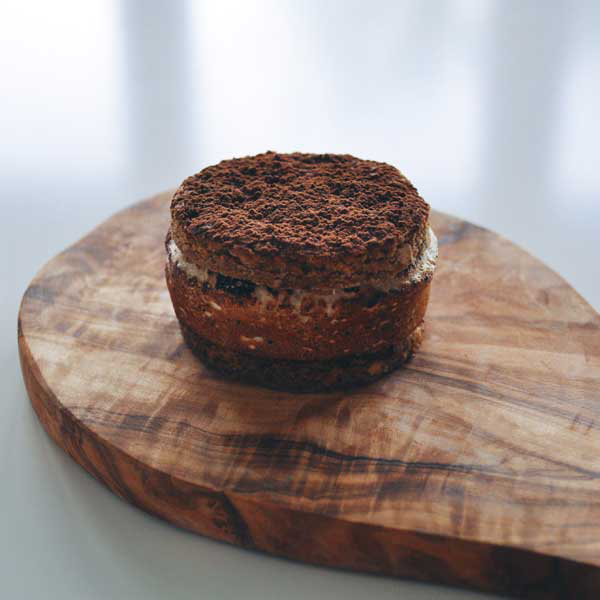
When I was 5 years old, I went to a friends birthday party. We had cake, played pass the parcel and then a game called "fluffy bunny". Each person had to stuff as many marshmallows as they could into their mouths, then try and say "I'm a fluffy bunny". I won (always the pig), but projectiled marshmallow pieces everywhere, and didn't eat another for about 15 years.
My marshmallow trauma is much milder these days, so thought I'd post up this twist on a classic American treat.
The mallow is made with a combination of freshly brewed espresso and ground espresso beans, while I'm using the very mild Koeze Cream-nut peanut butter (which you can now get at M&S in the UK) for the soft cookies.
Makes 4
Ingredients
For the marshmallow
- 220g Caster sugar
- 100ml Water
- 30g Liquid glucose
- 70ml freshly brewed espresso, cooled
- 5 leaves of gelatine
- 1tsp Vanilla extract
- 1tsp Coffee liquor (Illy Cafe is a good choice)
- 30g egg whites
- 5g Dark roasted espresso beans, finely ground (fresh if you can)
- Icing sugar to dust
For the cookies
- 25g dark brown sugar
- 25g caster sugar
- 25g unsalted butter
- 100g crunchy, unsalted peanut butter (Cream-nut works well)
- 20g Dark molasses
- 1 tsp vanilla extract
- 1 egg yolk
- 2 tbsp water (adjustable according to how dry your peanut butter is)
- 50g Type 45 flour
- 2g Bicarbonate of Soda
For the topping
- Cocoa powder
Equipment required
- Stand mixer
- Thermometer
- Tall sided baking tray, approx. 20cm x 20cm
- Silicone mat
- 7cm circular pastry cutter
- Blow torch
For the mallow
Cut the gelatine leaves in half and place them in a bowl with the cooled espresso so that they are completely covered.
Place the caster sugar, liquid glucose and water in a heavy bottomed pot over a high heat. Put your thermometer in the liquid and let it rise to 127 degrees C. This process takes around 10 minutes.
While you're waiting for the sugar to heat, place your 30g of egg white in the stand mixer with the whisk attached. You have to be a little careful with over whipping the egg before time, so wait until the thermometer is around 124 or 125 degrees, then start whipping on a high heat.
 At the 127 degree point - and do this carefully - slide the gelatine and cooled espresso into the hot sugar syrup. It will bubble away vigorously, and you'll need to give it a quick stir. At this point, your egg whites should be stiff but not over beaten. Keep the mixer on high, and slowly pour the syrup mixture down the side of the stand mixer bowl. Add the vanilla extract.
At the 127 degree point - and do this carefully - slide the gelatine and cooled espresso into the hot sugar syrup. It will bubble away vigorously, and you'll need to give it a quick stir. At this point, your egg whites should be stiff but not over beaten. Keep the mixer on high, and slowly pour the syrup mixture down the side of the stand mixer bowl. Add the vanilla extract.
After 5 minutes, add the coffee liquor. Let this beat for another 5 minutes until relatively cool and extremely thick - you'll know when it's done because your stand mixer will start to sound like it has just run a marathon. Right at the last moment, tip in the ground espresso beans and let it mix for another 30 seconds.
Take a square, tall sided baking tray - approx 20 cm x 20 cm - and oil the base. Place a sheet of cling film on that and press it into the sides. Now gently oil the cling film, and scatter over some icing sugar so that all the oil is covered. When the mallow mix is ready, use a spatula to pour it out into the tray. Use a wet palette knife to smoothen the top. Place this in the fridge for about 2 hours to set.
For the cookies
 Take a bowl and place the two sugars, butter, peanut butter, egg yolk, molasses and vanilla extract inside. Blend all of these together with a wooden spoon (or electric mixer) until you get a reasonably smooth paste. Sift in the flour and bicarb, then blend again until the mixture starts to resemble wet sand.
Take a bowl and place the two sugars, butter, peanut butter, egg yolk, molasses and vanilla extract inside. Blend all of these together with a wooden spoon (or electric mixer) until you get a reasonably smooth paste. Sift in the flour and bicarb, then blend again until the mixture starts to resemble wet sand.
At this point, tip it out onto your work surface and press the dough together so that the heat of your hands starts to make it solid. Take 1 tbsp of water and add it to the mix to help the process; you may need 2 tbsp to make the dough come together. You're looking for something that resembles a cookie dough - hopefully the image here will help. Roll into a ball and press down. Cover this in cling film, then put into the freezer for 10 minutes to rest. Pre-heat your oven to 180 degrees C.
As we're going to cut these cookies out, we'll initially bake the lot in one sheet. Take the dough from the freezer and place it on a silicone mat on top of a heavy tray. Dust your rolling pin with a little flour, then roll out the dough to a thickness of around 5mm. Place in the oven for 10 minutes.
When time is up, you should see that the cookies are golden but soft. Take them out, and cut 8 rounds with the cutter. Move away any cut-off biscuit (it's for the chef) and return the 8 rounds to the oven for a further 2 minutes to brown off the edges.
Assembly
Take the marshmallow out of the fridge, and invert it onto an icing sugar dusted chopping board. Peel of the cling film, and use the same 7cm cutter from the cookie section to cut 4 rounds of mallow.
Place one round of mallow on your palette knife, then toast the edges and the top with a blow torch. It will probably catch fire, and that's what you want - just be careful not to burn your kitchen or any nearby loved ones.
When it looks suitably browned, slide the mallow from the knife onto one of the biscuit rounds, then top with a second round.
Repeat with the other 3 S'mores, then dust with the cocoa powder and serve while the mallow is hot and soft.
Passion fruit and Jasmine Tart
Delicious curd filling with a thick Italian meringue topping
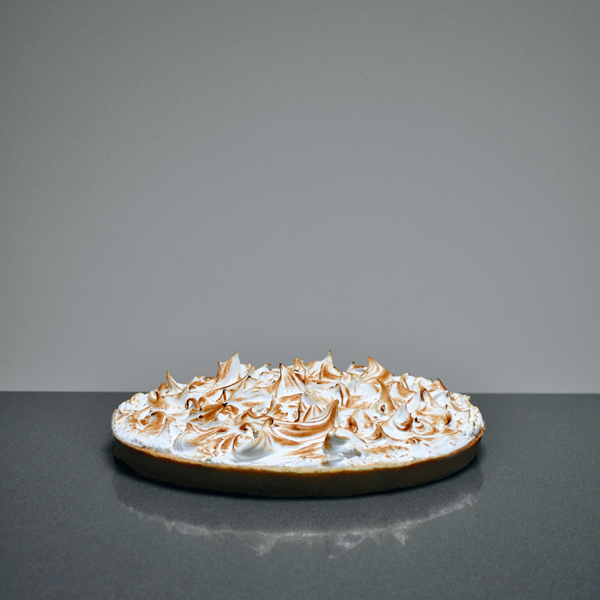
Sometimes I find my entire fridge is full of random bowls of leftover egg whites. I'm still not entirely sure where these come from, but I guess I'm either making a lot of ice cream or they are naturally multiplying in there. Eventually I need a purge, and this recipe is ideal.
The combination of passion fruit and jasmine tea is really delicious, but that toasted Italian meringue topping provides the killer blow. I say "serves 8" below, but it depends on how many of your guests are in pig mode (read: I ate most of the one pictured).
Ingredients (one pie, serves 8)
For the filling
- 150g Passion fruit juice (from 8 to 10 passion fruit, seeds sieved out)
- 3 large eggs
- 100g unsalted butter
- 210g caster sugar
- 15g Jasmine tea pearls [Buy]
For the tart case
- 250g type 45 flour [Buy] (or just plain if you don't have any)
- 140g unsalted butter (softened)
- 1 large egg
- 1 large egg yolk
- 40g ground almonds
- 90g icing sugar
- 1tsp vanilla extract
For the Italian meringue
- 200g egg whites
- 75g caster sugar (for the egg whites)
- 325g water
- 85g caster sugar (for the sugar syrup)
Equipment required
- 24 cm flan ring
- Stand mixer
- Thermometer
- 1 baking mat (Fibrelux, Silpat etc)
- 1 heavy tray
- Baking beans or equivalent
Make the curd
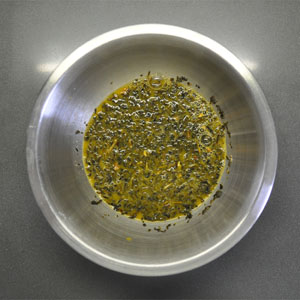
Next, measure your tea out, and get an empty bowl ready with another sieve over the top. Pour the juice into a small heavy bottomed pot over a low heat, and use a thermometer to get the temperature up to 85C. As soon as it hits, take it off the heat and stir in the jasmine pearls. Set a timer for 3 minutes.

Now prepare a double boiler - bring water to a simmer in a pot, and place a clean bowl over the top. Pour in the brewed juice, sugar, butter and let them melt together, stirring occasionally. Beat the three eggs until they are homogeneous, then pour that into the juice. Make sure the water stays at a simmer or you'll get scrambled eggs.
Stir slowly until combined, then keep it on the low heat and stir every few minutes. Eventually - and that might be 10 or more minutes - the eggs will start to thicken up as they cook. When you reach a nice, thick texture, take it off the heat and strain it again into a clean bowl. Note that as it's hot, it will look more "liquid" than curd normally does. If you want to test the thickness, take a teaspoon out and leave it on the side for a few minutes; if it's thick enough you're done. Leave to cool, then cover with cling film and place in the fridge for a few hours to firm up.
Make, bake and fill the tart case
This is pâte sucrée, so be prepared for some falling-apart-madness.Attach a whisk to your stand mixer, and add the butter. Whip until the butter has been creamed, then add the vanilla extract, icing sugar, ground almond and eggs. When combined, tip about 1/3 of the flour in. It should be combined in a few seconds, so repeat with the next 1/3 and then the final amount of flour. Stop the mixer when the mixture looks combined and a bit like wet sand.
Turn this out onto your work surface and press it all into a smooth ball. Place the ball on some cling film, then flatten slightly with the palm of your hand. Wrap it in the cling and place in the fridge for at least 2 hours.
When the pastry has rested, take your baking mat and place it on a tray, then the flan ring on top of this. Remove the pastry from the fridge and, working really quickly, flour it and use a floured rolling pin, roll to a thickness of about 3mm. Dust it with flour again, then roll the pastry back over the rolling pin, lift, and unroll over the flan ring. This is the part where disaster can strike, so try and start the unrolling with enough "edge" to cover the closest part to where you're standing. If it has worked, start pushing the dough into the edges of the ring, leaving any excess folded over the top. Don't trim it yet. If you find any cracks, just patch them with spare pieces of pastry or some of the edge overhang.
Turn your oven on to 170C. To help stop shrinkage, freeze the tart case instead of just putting it in the fridge. Leave it in there for about 30 minutes until nice and cold. When you're ready to blind bake, quickly remove the case from the freezer and place some silver foil (matte side down) into it. You will probably need two pieces going in alternate directions to cover the whole ring. Scrunch it down over the top edges of the case so it's completely covered in foil, then gently pour in your baking beans.
You need to add a bit of extra cooking time due to the frozen case, so bake for about 20 minutes. After this time it should look anaemic but be solid - so remove the foil and beans, then brush with a beaten egg and return to the oven for a further 5 minutes. Now it should be golden.
Remove and leave to cool for about 10 minutes, then use a sharp paring knife to trim the outer edge. Carefully remove the ring, then brush out any pastry crumbs.
After it has completely cooled, take your curd and spoon it into the case. Use a spoon or palette knife to even the filling out. Cover with cling film, then place in the fridge to firm up again.
Italian meringue and putting it all together
This is the fun part. Place your 200g of egg whites into your stand mixer with the whisk attachment. Pour 325g of water into a heavy bottomed pot, add the 85g of sugar, and place over a high heat. While the syrup is boiling, whisk the whites until they are stiff. Reduce the speed, then shower in the sugar until combined.Use a thermometer to measure the temperature of the sugar - when it hits 118C, remove from the heat, whack the stand mixer up to full power and slowly trickle the syrup over the beaten egg whites. Leave this to whisk until completely cool, then place into a piping bag without a nozzle (you just want to get it onto the tart without disturbing the curd).
Remove the tart from the fridge. Gently pipe the meringue over the curd, making sure the centre has a bit more than the outside. When it's all in, use a wet palette knife to even out the mass into a small hill. Use a fork to gently "knick" the surface and create small curls - the more of these you have, the more surface area you're going to get toasted and the better it will taste.
When you're happy, grab the blow torch and toast the top. The smell is unbelievable.
Either serve straight away if you want the curd to be nice and runny, or place in the fridge for an hour or so to firm up. When I take a slice, I like to torch the sides again to make even more of that toasted flavour.
